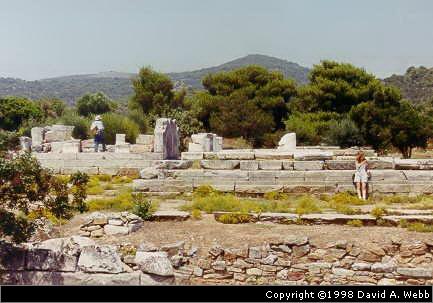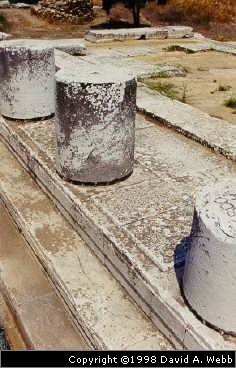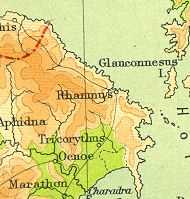

 North of the plain of Marathon, but still further S of the Amphiaraion
and Oropos, the remains of the Attic deme site of Rhamnous can be found.
But don't expect a line of touristy stalls or even a single periptero here.
The site is very isolated, and you probably won't make it out here without
your own vehicle. It is quiet and the view from the sanctuary down
to the Euboean Gulf is noteworthy (photo here doesn't quite do it justice).
I can't remember if they had guide books at the entrance, but they probably
do. This site has one worth picking up if you like springing for these
sorts of things.
North of the plain of Marathon, but still further S of the Amphiaraion
and Oropos, the remains of the Attic deme site of Rhamnous can be found.
But don't expect a line of touristy stalls or even a single periptero here.
The site is very isolated, and you probably won't make it out here without
your own vehicle. It is quiet and the view from the sanctuary down
to the Euboean Gulf is noteworthy (photo here doesn't quite do it justice).
I can't remember if they had guide books at the entrance, but they probably
do. This site has one worth picking up if you like springing for these
sorts of things.
The area was known in antiquity (since the 6C BC) for
the worship of Nemesis, that avenging goddess who represented the righteous
anger of the gods. She was particularly nasty towards the proud and
insolent. The site was the northernmost deme of Attica and became  strategically important during the Peloponnesian War when the Athenians
were forced to use it as the only viable port of entry for grain from Euboea.
All of this took place in 412 BC, after Athens lost Dhekelia.
strategically important during the Peloponnesian War when the Athenians
were forced to use it as the only viable port of entry for grain from Euboea.
All of this took place in 412 BC, after Athens lost Dhekelia.
The site today is not wholly accessible to the public. The center of the deme site was located near the acropolis, but this part of the area is still closed. In the picture above, the acropolis is visible as the small hill at the end of the ravine. The hill and the fortress which surmounted it, lie above two small harbours. A gymnasium, theatre , a shrine of Amphiaraos, and numerous other buildings were found near the acropolis. The circuit wall of the fortress, with gateways and the remains of nine towers visible.
The main attractions of the site, which you can visit,
are the remains of the two temples, further up the ravine. A 6C BC
Temple of Nemesis existed on the site, but when the Persians occupied Attica
in 480, they destroyed it. Soon after, a large platform was built up,
45m wide, as a sacred precinct. The large retaining walls that hold
up the platform are still visible along the sides of the precinct. The
smaller Temple (of Themis?) was built early in the 5C BC (in the second picture
above, the Temple of Themis is the one on the left, further back and smaller).
The attribution to Themis is based in part on two marble seats found inside
the temple, dedicated to Themis and Nemesis. It was used as a treasury
and as a storeroom down into the 4C AD. The building measures 10.7m
by 6.5m.
the platform are still visible along the sides of the precinct. The
smaller Temple (of Themis?) was built early in the 5C BC (in the second picture
above, the Temple of Themis is the one on the left, further back and smaller).
The attribution to Themis is based in part on two marble seats found inside
the temple, dedicated to Themis and Nemesis. It was used as a treasury
and as a storeroom down into the 4C AD. The building measures 10.7m
by 6.5m.
The larger Temple of Nemesis was constructed in the mid to later 5C BC. It was thought for some time to have been one of a series of temples built by the "Theseion Architect." But recent scholarship has indicated that it was probably constructed later than the other temples, and therefore more likely a seperate undertaking. The temple itself was never actually completed as the photo above shows. The flutes on the columns were never completely cut out and the protective layer of marble that was normally not chipped away till after the stones were transported was never removed in many places (note the spaces in between the columns and on the step faces). In the early Roman period, it was rededicated to the Empress Livia (wife of Augustus, mother of Tiberius, and grandmother of Claudius) after her death, around AD 45.
A building to the S holds the remnants of the restored entablature of the larger temple, but don't even think about gaining access from the archaeologists. The road that passes from the temple down to the deme site is known as the sacred way. Many funeral enclosures and monuments can be seen walking down it (in the other direction it runs from the temples to the car park).
The site will probably only be visited by the die-hard archaeologists or classically minded, but if you're sick of the crowded streets of Athens, and you have access to a vehicle, it would be a nice day trip up to the sanctuary to relax. There are a few shade trees and the precinct platform was just high enough to encourage a nice breeze when I was there. Just don't forget to pack some snacks and bring your water.
I would like to thank Ann Blasingham for her explanations
and tour of this site as well as for the bibliographies below.
 Bibliography:
Bibliography: Inscriptions:
IG 2 3242
Deme Site:
(Lists only publications not included
in bibliography of Petrakos 1991.)
Petrakos, V. Rhamnous. Athens,
1991.
Travlos, J. Bildlexikon zur Topographie
des antiken Attika. Tubingin, 1988, 388-403.
Temple of Nemesis and Cult Image
by Agorakritos:
(Lists only publications not included
in bibliography of Petrakos 1991.)
Despinis, G. "Discovery of the Scattered
Fragments and Recognition of the Type of Agorakritos' Statue of Nemesis."
AAA 3 (1970), 403-414.
Dinsmoor, W.B. Jr. "Rhamnountine Fantasies,"
Hesperia 30 (1961), 179-204.
Edwards, C.M. "Tyche at Corinth,"
Hesperia 61 (1990), 529-542.
Hodge, A.T. and R.A. Tomlinson. "Some
Notes on the Temple of Nemesis at Rhamnous," AJA 73 (1969), 162-185.
Karusu, S. "Ein Akroter klassischer Zeit,"
AthMitt 77 (1962), 178-190.
Langlotz, E. "Eine Metope des Nemesistempel
in Rhamnus," in Scritti in onore di Bartolomeo Nogara. Vatican City,
1937, 225-230.
Lapatin, K.D.S. "The Reconstruction of
the Temple at Rhamnous? Who is who on the Nemesis Base?" Hesperia
61 (1992), 107-119.
Miles, M.M. "The Reconstruction of the
Temple of Nemesis at Rhamnous." Hesperia 58 (1989), 134-256.
Petrakos, V. Rhamnous. Athens,
1991.
Thompson, H.A. "Athens Faces Adversity."
Hesperia 50 (1981), 346-348.
Travlos, J. Bildlexikon zur Topographie
des antiken Attika. Tubingin, 1988, 388-403.
de Waele, J.A.K.E. "The Design for the
Temple of Nemesis at Rhamnous," in M. Gnade, ed., Stips Votive, Papers
Presented to C.M. Stibbe. Amsterdam, 1991, 249-264.
Wilhelm, A. "Themis und Nemesis von Rhamnous."
OJb 44 (1942), 200-209.
Links:
